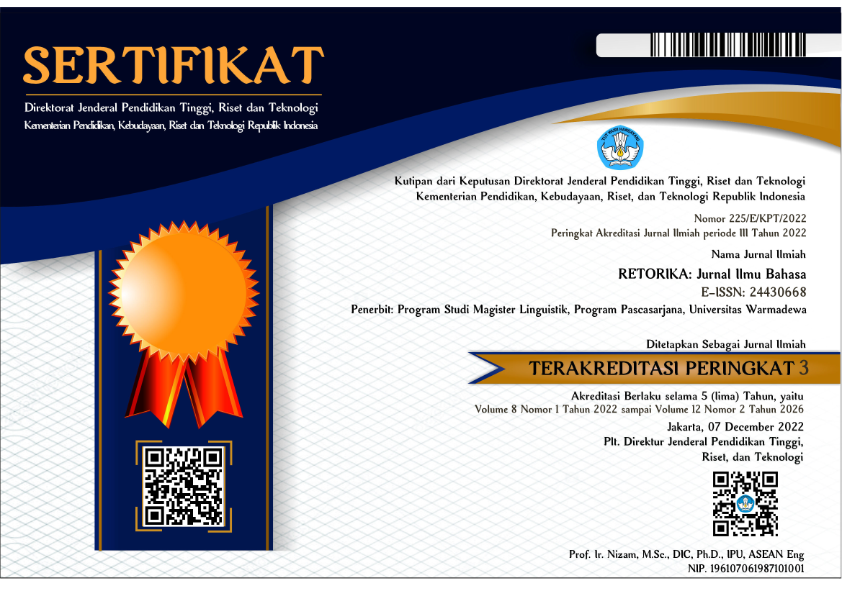Semantic Structure Verb ‘open’ in Indonesian and Japanese : Natural Semantic Metalanguage
Abstract
This study discusses the semantic structure of the verb 'open' in Indonesian and Japanese. This research uses the MSA theory pioneered by Wierzbicka. Data was obtained and collected using the interview method. The results of the findings obtained two categorizations of the verb 'open' in Indonesian and Japanese, they are: a) using tools (by using tools) and b) using hands (by part of body). The semantic structure of the verb 'open' in Indonesian and Japanese is almost similar. Even so, there are several different verbs in the semantic structure, including: meretas (é–‹å°ã™ã‚‹kaifÅ« suru), merintis & merambah (é–‹æ‹“ã™ã‚‹ kaitaku suru), mementang, membentangkan, membeber, menggelar & menghamparkan (広ã’ã‚‹hirogeru), dan menyingkap (æ²ã‚‹mekuru & ã¯ã ã‘ã‚‹hadakeru). The difference in the semantic structure of the Indonesian and the Japanese language occurs due to the cultural characteristics of the two peoples and the different language differences. Thus, it also results in a different mindset in each language.
References
Adhiti, I. A. I. (2021). Peran Khusus Verba “Menarik†Dalam Bahasa Bali Kajian Metabahasa Semantik Alami. Widyadari, 22(1), 252–262. https://doi.org/10.5281/zenodo.4661363
Ameka, F. K. (2019). “The nut opens†and “Hunger endsâ€: Verb Constructions at The Syntax-Semantics Interface. In B. James, Essegbey; Dalina, Kallulli; Adams (Ed.), The Grammar of Verbs and their Arguments: A Cross Linguistic Perspective (pp. 59–84). Rüdiger Köppe Verlag. https://www.koeppe.de/titel_the-grammar-of-verbs-and-their-arguments
Ameka, F. K., & Hill, D. (2020). The Comparative Semantics of Verbs of ‘opening’: West Africa vs Oceania. In Meaning, Life and Culture: In conversation with Anna Wierzbicka (1st ed., Issue December, pp. 33–59). Australian National University Press. https://doi.org/10.22459/mlc.2020.02
Ana, I. W. (2017). Makna “Memancing†Bahasa Bali Dialek Desa Lembongan: Kajian Metabahasa Semantik Alami. KULTURISTIK: Jurnal Bahasa Dan Budaya, 1(1), 12. https://doi.org/10.22225/kulturistik.1.1.213
Bowerman, M. (2005). Meaning, Life and Culture: In conversation with Anna Wierzbicka. In Helen Bromhead and Zhengdao Ye (Ed.), Meaning, Life and Culture: In conversation with Anna Wierzbicka (1st ed.). ANU Press. https://doi.org/https://doi.org/10.2307/j.ctv1d5nm0d
Dewi, S. S., Mulyadi, M., & Pujiono, M. (2019). Struktur Semantis Verba Kiru ‘Potong’: Kajian Metabahasa Semantik Alami. Izumi, 8(2), 101. https://doi.org/10.14710/izumi.8.2.101-124
Erawati, N. K. R., & Sulibra, I. K. N. (2017). Speech Act Verb in Old Javanese : Natural Semantics Metalanguage Analysis. International Journal of Language and Linguistics, 4(2), 71–80. http://ijllnet.com/journal/index/2359
Goddard, C. (1998). Semantic Analysis: A Practical Introduction (Issue October). Oxfor University Press.
Goddard, C., & Wierzbicka, A. (2009). Contrastive Semantics of Physical Activity verbs: “Cutting†and “Chopping†in English, Polish, and Japanese. Language Sciences, 31(1), 60–96. https://doi.org/10.1016/j.langsci.2007.10.002
KBBI Daring. (n.d.). Retrieved September 2, 2021, from https://kbbi.kemdikbud.go.id/entri/membuka
Levison, L. (1993). The Topic is Open. Penn Review of Linguistics, 1(January), 11.
Majid, A., Bowerman, M., Van Staden, M., & Boster, J. S. (2007). The Semantic Categories of Cutting and Breaking Events: A crosslinguistic Perspective. Cognitive Linguistics, 18(2), 133–152. https://doi.org/10.1515/COG.2007.005
Mulyadi. (2003). Struktur Semantik Verba Tindakan Bahasa Indonesia. USU Digital Library, 1(1), 1–18. https://doi.org/10.2139/ssrn.3948768
Mulyadi. (2012). Verba Emosi Bahasa Indonesia dan Bahasa Melayu Asahan : Kajian Semantik Lintas Bahasa. Universitas Udayana.
Neale, M. (2015). A Comparison of English and Japanese Proverbs Using Natural Semantic Metalanguage. New Voices in Japanese Studies, 7, 85–102. https://doi.org/10.21159/nvjs.07.05
Sianturi, S., . M., & Br. Sembiring, E. M. (2020). Semantic Structure of Verbs ‘Touch’ in Indonesian and Batak Toba Language. Asian Research Journal of Arts & Social Sciences, 10(1), 21–31. https://doi.org/10.9734/arjass/2020/v10i130138
Sudaryanto. (2015). Metode dan Aneka Teknik Analisis Bahasa. Duta Wacana University Press.
Syahputra, F. P., & Sinar, T. S. (2018). STRUKTUR SEMANTIS VERBA SENTUH BAHASA INDONESIA. Haluan Sastra Budaya, 2(1), 77–89.
Wahyuni, A. (2019). Semantic Structure Of Japanese Action Verbs In Novel Yoshiwara Gomenjoo. Jurnal Kata, 3(2), 266–274. https://doi.org/10.22216/jk.v3i2.4174
Widani, N. N. (2017). Makna “Mengambil†Bahasa Bali: Pendekatan Metabahasa Semantik Alami (MSA). RETORIKA: Jurnal Ilmu Bahasa, 2(1), 127. https://doi.org/10.22225/jr.2.1.53.127-141
Wierzbicka, A. (1998). Semantic : Primes and Universal. Language, 74(1). https://www.researchgate.net/publication/225084610_Semantic_Analysis_A_Practical_Introduction
Copyright (c) 2023 RETORIKA: Jurnal Ilmu Bahasa

This work is licensed under a Creative Commons Attribution-ShareAlike 4.0 International License.
This journal provides immediate open access to its content on the principle that making research freely available to the public supports a greater global exchange of knowledge.
All articles published Open Access will be immediately and permanently free for everyone to read and download. We are continuously working with our author communities to select the best choice of license options, currently being defined for this journal as follows: Creative Commons-Non Ceomercial-Attribution-ShareAlike (CC BY-NC-SA)
 Abstract viewed = 196 times
Abstract viewed = 196 times
 PDF downloaded = 191 times
PDF downloaded = 191 times

2.png)














